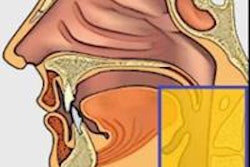
Radiologists can make use of iPads to diagnose thoracolumbar spine fractures on radiographs, performing just as well as they would on traditional PACS diagnostic workstations, Greek researchers reported at the recent RSNA meeting in Chicago.
"Diagnosis was as accurate on the iPad as on the diagnostic monitors," said presenter Dr. Maria Tzalonikou of Hygeia Hospital in Athens.
Seeking to evaluate the usefulness of tablets for diagnosing thoracolumbar fractures in their general hospital's emergency department, the researchers performed a retrospective study of 61 consecutive thoracolumbar trauma cases. The 61 cases included 36 with fractures and included both acute and chronic cases.
Two attending radiologists and two radiology residents independently read the anonymized and randomized cases twice, first on an iPad 2 and then a week later in a different order on diagnostic monitors in the radiology department. The DICOM images were sent to the iPad using a compressed 1,263 x 1,536 matrix, according to the researchers.
The iPad 2 offers max luminance of 388 cd/m2, a contrast ratio of 962:1, and a display resolution of 1,024 x 768 at 132 pixels per inch. The 9.7-inch display uses a backlit light-emitting diode (LED) screen and employs a 4:3 aspect ratio.
In comparison, the diagnostic monitors provide maximum luminance of 1,000 cd/m2, a 900:1 contrast ratio, and a display resolution of 2,048 x 1,536 at 123 pixels per inch. The 20.8-inch monitor uses a thin-film-transistor (TFT) liquid-crystal display (LCD) and a 4:3 aspect ratio.
| Correct diagnoses on iPad | Incorrect diagnoses on iPad | Correct diagnoses on diagnostic monitors | Incorrect diagnoses on diagnostic monitors | |
| Attending radiologists | 103 | 19 | 104 | 18 |
| Radiology residents | 107 | 15 | 99 | 23 |
| Total | 210 | 34 | 203 | 41 |
| iPad | Diagnostic monitors | |
| Sensitivity | 87.5% | 89.6% |
| Specificity | 84% | 74% |
| Positive predictive value | 88.7% | 83.2% |
| Negative predictive value | 82.4% | 83.2% |
| Accuracy | 86.1% | 83.2% |
"The iPad seems to be as good or maybe slightly superior than diagnostic monitors when diagnosis of thoracolumbar spine fractures is needed to be made," she said.
Their findings are in concordance with other studies in the literature that examined the performance of tablets for a variety of clinical applications. A number of studies have outlined the potential usefulness of handheld devices for interpreting CTs in patients with intracranial emergencies and hemorrhage, pulmonary emboli, and renal pathology, Tzalonikou said, adding that other research has described their utility for interpreting x-rays for neonatal and infantile lung pathology, pediatric fractures, distal radial fractures, and other extremity fractures.
At the 2013 RSNA meeting, the researchers presented a study that found radiology attendings and residents were as accurate on the iPad as they were on the diagnostic monitors for diagnosing extremity fractures. Furthermore, subsequent research presented at the 2014 annual meeting of the European Society of Pediatric Radiology (ESPR) by the group also found no difference in interpretation accuracy between iPads and diagnostic monitors for diagnosing chest x-rays of neonates and infants in the emergency department, she said.
iPad's advantages
The iPad offers many advantages, including portability, a low weight, easy-to-use apps, a high-quality display, and a high contrast ratio. Users can also access data from multiple sites and facilitate instant consultation, she said. Limitations include a small screen size and limited data security.
Despite the iPad's advantages and clinical utility, the researchers still believe diagnostic monitors will continue to be used by radiologists for primary diagnosis in the hospital setting, mostly due to their advantages in screen size and luminance, Tzalonikou said.
Nonetheless, "the iPad and other tablets will play an important role when it comes to providing remote diagnosis," she said.



















